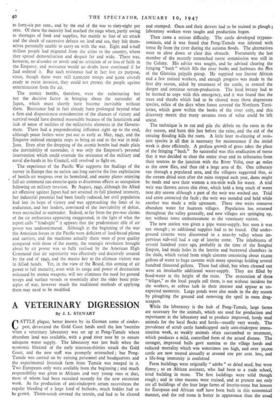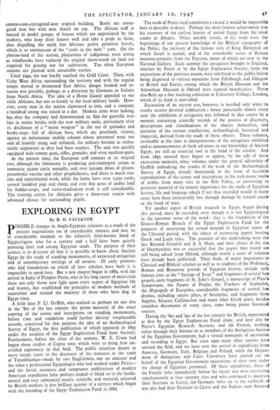A VETERINARY DIGRESSION
By J. L. STEWART
CATTLE plague, better known by its German name of rinder- pest, devastated the Gold Coast herds until the late 'twenties when a veterinary laboratory was set up at Pong-Tamale where abundant land was available, with a good river near by to ensure adequate water supply. The laboratory was just built when the economic blizzard of the early nineteen-thirties struck the Gold Coast, and the new staff was promptly retrenched ; but Pong- Tamale was carried on by existing personnel and headquarters and the experimental livestock farm from Tamale was merged in it. Two Europeans only were available from the beginning ; and much responsibility was given to Africans and very young ones at that, most of whom had been recruited recently for the new extension work. As the production of anti-rinderpest serum necessitates the regular bleeding of a large herd of bullocks, much fodder had to be grown. Thorn-scrub covered the terrain, and had to be cleared
and stumped. Oxen and their drivers had to be trained to plough ; laboratory workers were taught and production began.
Then came a serious difficulty. The cattle developed trypano- somiasis, and it was found that Pong-Tamale was infested with tsetse fly from the river during the autumn floods. The alternatives were to close down or clear this obstacle. Fortunately the last member of the recently retrenched tsetse commission was still in the Colony. His advice was sought, and he advised clearing the fringing " bush" which fills the river banks and harbours the flies of the Glossina palpalis group. He supplied one literate African and a few trained workers, and enough progress was made in the first dry season, aided by treatment of the cattle, to control the danger and continue serum-production. The local botany had to be learned to cope with this emergency, and it was found that the trees and shrubs which had to be cleared were those degenerate species, relics of the days when forest covered the Northern Terri- tories, which grow within the banks of the river only, and this discovery meant that many savanna trees of value could be left uncut.
The technique is to cut and pile the debris on the roots in the dry season, and burn this just before the rains, and the aid of the ensuing flooding kills the roots. A little later re-clearing of resis-
tant species is all that is necessary for maintenance if the initial work is done efficiently. A profuse growth of grass takes the place
of the fringing "bush." So successful was this eradication of tsetse that it was decided to clear the entire river and its tributaries from their sources to the junction with the River Volta, over 4o miles as the crow flies, and thus rid a large area of fly. One tributary ran through a populated area, and the villagers suggested that, as the stream dried soon after the rains stopped each year, dams might be made and save their women a ten-mile walk for water. A trial weir was thrown across this river, which held a long reach of water next dry season although a part of the weir was washed out. Trial and error corrected the fault ; the weir was mended and held while another was made a mile upstream. These two weirs conserve abundant water for fourteen villages. Population has returned throughout the valley generally, and new villages are springing up, not without some embarrassment to the veterinary station.
The new station was given a pipe water-supply, but soon it was not enough ; so additional supplies had to be found. Old under- ground cisterns were discovered in a near-by valley where im- pervious sub-soil had a cap of laterite stone. The inhabitants of several hundred years ago, probably in the time of the Songhai
Empire, had made holes in the laterite and burrowed chambers in
the shale, which varied from single cisterns containing about io,000 gallons of water to huge caverns with many openings holding several hundred thousand gallons. These had silted, but when cleaned out were an invaluable additional water-supply. They are filled by flood-water at the height of the rains. The restoration of these " biligas," as the local people call them, is not without incident for the workers, as cobras lurk in their interior and appear at un- expected moments. Large ponds were also made in the dry season by ploughing the ground and removing the spoil in oxen drag- scrapers.
While the laboratory is the hub of Pong-Tamale, large farms are necessary for the animals, which are used for production and
experiment at the laboratory and to produce improved, hardy stud animals for the local flocks and herds—usually very weedy. The prevalence of scrub cattle handicapped early anti-rinderpest immu- nisation work, as weakly animals often succumbed to treatment, which produces a mild, controlled form of the actual disease. The stronger, improved bulls gave stamina to the village herds and reduced mortality which was sometimes too high, and over 5o,000 cattle are now treated annually at around one per cent. loss, and a life-long immunity is conferred.
Farm buildings were originally " adobe " or dried mud, but were flimsy ; so an African assistant, who .had been to a trade school, tried building in stone. The first buildings were solid though.
rough ; and in time masons were trained, and at present not only are all buildings of the four large farms of laterite-stone but houses
for European and African staff have been built in this economical manner, and the red stone is better in appearance than the usual
cement-cum-corrugated-iron tropical building. Roofs are corru- gated iron bin with neat thatch on top. The African staff is housed in model groups of houses which are appreciated by the workers, who keep their houses well and take a pride in them, thus dispelling the myth that Africans prefer primitive hovels, which is so reminiscent of the " coals in the bath " yarn. On the plateau-land of the station, plantations of indigenous trees acting as windbreaks have replaced the original thorn-scrub on land not required for grazing nor for cultivation. Too often European stations are planted with unsuitable exotics.
Until 1940, the war hardly touched the Gold Coast. Then, with Vichy West Africa surrounding the territory and with the regular troops moved to threatened East Africa, danger loomed and in- vasion was possible, perhaps as a diversion by Germans or Italians from North Africa. The idea of a Home Guard appealed to our virile Africans, but not so keenly to the local military heads. How- ever, every man in the station clamoured to join, and a company a hundred strong was raised in a day. Modern arms were lacking, but after the company had demonstrated its flair for guerrilla war- fare in mimic battles with the new military units, particularly after its disclosure of a " secret weapon " in the use of grenades and booby-traps full of African bees, which are peculiarly vicious, against an unfortunate mobile column whose personnel were one and all heartily stung and defeated, the military became as enthu- siastic supporters as they had been sceptics. The unit was quickly equipped with tommy guns, rifles, grenades and even machine-guns.
At the present time, the European staff remains at its original two, although the laboratory is producing anti-rinderpest serum to immunise 50,00o cattle annually, and over 250,000 doses of pleuro- pneumonia vaccine and other prophylactics, and there is much rou- tine and experimental work, while the farms have over 1,soo cattle, several hundred pigs and sheep, and over 800 acres of arable land for fodder-crops, and tsetse-eradication work is still considerable. The training centre for Africans gives a three-year course with advanced classes for outstanding pupils.



































 Previous page
Previous page